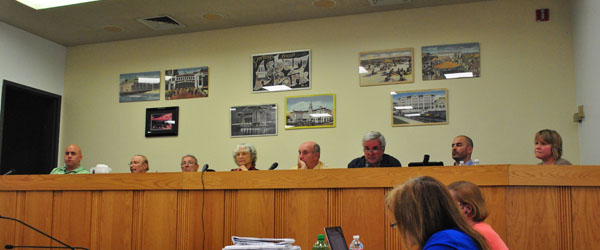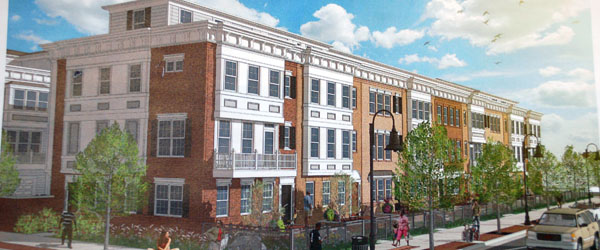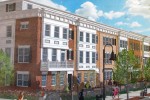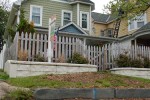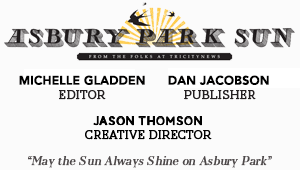K Hov. townhome project delayed by planning board
Objections raised concerning the configuration of the buildings
Master Waterfront redeveloper iStar Residential will have to wait another two weeks before the Asbury Park Planning Board votes on an application for a proposed townhome development on the western edge of the waterfront redevelopment zone.
The application for national homebuilder K. Hovnanian to erect 28 townhome units within the western portion of the block bound by Grand, Sewall and Monroe avenues and Heck Street was carried over from the May 19 meeting to the June 9 meeting. The May 19 meeting concluded after over two-and-a-half hours of testimony and discussion between planning board members and project planners, architects and engineers.
Planning board members found themselves discussing the same issues the city’s Technical Review Committee [TRC] brought up before the matter passed to City Council for review, mainly the layout of the four buildings and the need to have the block developed in two phases. The council voted the project through 3-1 at their May 7 meeting.
“The manner in which this particular block is proposed to be redeveloped is consistent with the redevelopment plan and redeveloper agreement,” Brian Cheripka, vice president of land for iStar Residential, said in an email to the Sun. “Planning for South Grand began back in mid-2013, when we did not own all of the lots on the eastern half of the block. There is no financial concern. Breaking the project into two phases allowed us to accelerate much needed redevelopment in this area, keeping the momentum for economic growth.”
The proposed project, called “South Grand” is subdivided into two phases, phase one includes 28 townhome units on the western portion of the block. Two- and three-bedroom homes, constructed of brick and cementitious siding material are planned. Individual units provide either 2,300 or 2,900 square feet of living space and include private, two-car garages accessible from the rear of the buildings. Plans for the second phase of the project have not been formally submitted but may include a taller, “L” shaped building or more townhome units, according to project planner Keenan Hughes.
Initially, developers proposed three long structures that all ran parallel to Grand Avenue, with the westermost building fronting Grand Avenue and the other two buildings turned in to face each other to achieve what project planner Keenan Hughes calls a “mews” effect. At a subsequent TRC meeting, developers adjusted the layout of the two buildings that faced each other, basically slicing them in half and creating a fourth building to front Monroe Avenue. Brick was also carried over to the sides of the buildings along Sewall Ave, side entrances created, and a decorative cornice element added to each of the buildings.
Fredrick Heyer, one of the city’s planning and development consultants, presented an alternate site plan layout that simply turns the two 5-unit buildings that face in on each other outward to front Sewall Avenue. This plan both achieves the requirement for a pedestrian streetscape and does not reduce the size of the building.
Planning board member Sara Ann Towery, who is the chair of the city’s Technical Review Committee and herself an architect, argued for the site plan Heyer presented.
“[Heyer’s plan] does several things,” said Towery, “it faces all of the units out on the streets, it does allow for a second phase of construction, it gives you all of the parking spaces that you need— more parking spaces than you show on your conceptual plan. The only reason that we were not forcing you to do this at the TRC is because you said you did not own that lot. Now, you’ve testified that you do own that lot — there is no reason we shouldn’t have a better layout for this whole thing.”
Their nature of the objection stems from the visibility of the back of one of the buildings situated along Sewall Avenue, and whether the sides of the buildings that will front Sewall Avenue falls in line with the waterfront redevelopment plan, which places the onus of a pedestrian-friendly streetscape on the frontage of the building, calling it the “primary contribution to pedestrian activity,” according to a portion of the plan read by Heyer at the meeting.
Heyer’s plan does, however, leave an open space within the center of the development. If the “L” shaped building is constructed, the center lot would be used as on-site parking. Due to safety concerns in the area, the developer does not want potential homeowners to have to walk 300 to 400 feet from their cars to the building, Hughes said.
Several members of the planning board, along with Heyer, also question the need for the subdivision now that the entire tax block is owned by the developer.
During those initial planning stages, iStar did not yet own all of the lots on the block and reasoned the subdivision and “mews” layout was necessary to move development forward on the block until the final lot was acquired. The developer recently closed on the property and, now that the entirety of the block falls under the ownership of iStar, members of the planning board see no reason why the site plan cannot be adjusted.
Planning Board Attorney Jack Serpico expressed concern that the board could potentially issue approvals on a project that would never finish, which the board has experienced in Asbury Park’s tumultuous redevelopment history.
The application requires a temporary variance for lot frontage, which will be satisfied when both phases are complete.
In the event K. Hovnanian does not finish the construction, iStar — who is responsible for obtaining the permits and completing the project infrastructure — will. The developer has placed provisions in the existing agreements with K. Hovnanian that allow iStar’s to step in and complete the project, Cheripka said.
“As we have said all along, projects that start, must finish,” said Cheripka. “That said, we have every confidence in K. Hovnanian and their ability to deliver quality homes to the City of Asbury Park.”
Planning board member Robert Feinstein questioned how the aesthetics of the buildings fit the surrounding community.
“I’m not going to say if I like it or I dislike it; it does not feel like it is specifically designed for this location,” said Feinstein. “I’m trying to get an understanding as to why it looks the way it looks … I think we’ve done a good job, thus far, with downtown, redeveloping our neighborhood, our community, this feels like it dropped in from Anywheresville, USA … the Vive [townhome complex, located at the corner of Asbury Avenue and Kingsley Street] at least has a spirit unto its own. I know a lot of this is subjective, but this [design] is anywhere — Anywhere, USA.”
A team of over 40 people were involved in the conceptual design of the buildings, which achieve a modern urban aesthetic which takes into account the surrounding architecture and suits the project nicely, as it is positioned within the western edge of the waterfront redevelpoment zone along the gateway to the city’s downtown district, according to Project Architect Joesph Lipanovski.
Members of the planning board will make their decision on the project at the June 9 meeting.
————————————————————
Follow the Asbury Park Sun on Facebook and Twitter

